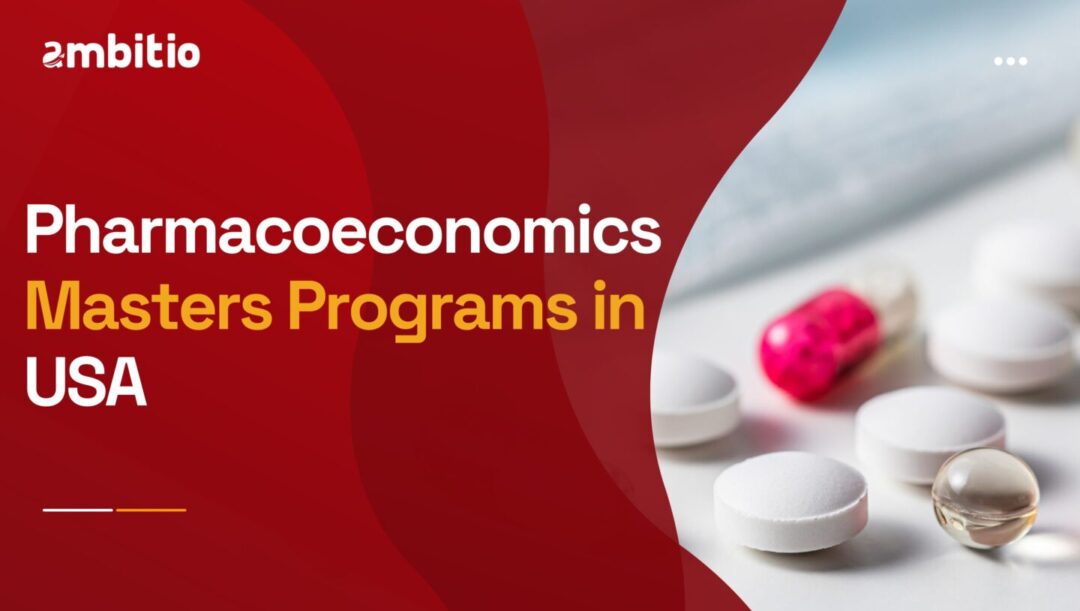17 December 2024
6 minutes read
Pharmacoeconomics Masters Programs in USA: The Definitive Guide for 2024

Key Takeaways:
- Interdisciplinary Field: Pharmacoeconomics combines health economics, clinical pharmacy, and patient outcome research to optimize healthcare outcomes and spending.
- In-Demand Career: The evolving complexity of drug development and healthcare policies heightens the demand for pharmacoeconomics professionals.
- Educational Pathways: Leading U.S. universities, such as the University of Florida and USC, offer comprehensive master’s programs in pharmacoeconomics.
- Curriculum Focus: Key courses include Health Technology Assessment, Health Care Microeconomics, and Applied Pharmacoeconomics, emphasizing both theory and practical application.
- Future Prospects: Graduates can influence health policy, contribute to public health improvements, and are well-placed in the job market due to the sector’s growing demands.
Pharmacoeconomics, a vibrant intersection of health economics and pharmaceutical policy, focuses on the cost-effectiveness of drug therapies, ensuring the best health outcomes for every dollar spent.
With healthcare costs on a persistent rise, expertise in this discipline becomes increasingly pivotal. If you’re eyeing a master’s in this specialty, the USA boasts some of the world’s leading programs.
An Introduction to Pharmacoeconomics
The Birth and Rise of Pharmacoeconomics
Pharmacoeconomics originated from the need to achieve optimal healthcare outcomes while ensuring judicious spending. Over the past few decades, it has matured into a discipline that bridges the knowledge gap between clinical outcomes, patient quality of life, and economic costs.
It’s a marriage of clinical pharmacy, health economics, and patient outcome research, aiming to identify, measure, and compare the costs and consequences of pharmaceutical products.
Why Pursue a Master’s in Pharmacoeconomics?
Given the ever-evolving landscape of the pharmaceutical and healthcare industries, there’s an urgent need for professionals who can navigate the complex dynamics of drug pricing, patient outcomes, and healthcare policies. Here are a few reasons why:
- In-Demand Profession: With drug development and regulatory landscapes becoming more complicated, there’s a rising demand for experts who can analyze the economic implications of drugs and health policies.
- Interdisciplinary Nature: Pharmacoeconomics straddles various disciplines, from pharmacy and medicine to economics and policy-making. This multi-faceted approach provides a holistic view of healthcare.
- Contribution to Public Health: Armed with this degree, professionals can influence health policies, ensuring the public gets access to the most cost-effective and beneficial treatments.
Research Programs Thoroughly:
Explore various universities’ curricula and specializations to find the program that aligns best with your interests and career goals.
Overview of Pharmacoeconomics Master’s Programs in the USA
Pharmacoeconomics master’s programs are designed to endow students with the necessary tools to evaluate and apply economic concepts to healthcare decision-making. These programs often fall under the umbrella of a university’s college of pharmacy or health sciences department.
University of Florida’s College of Pharmacy
Leading the way, the University of Florida’s College of Pharmacy offers a comprehensive curriculum, blending traditional teachings with real-world applications. They boast a rich tapestry of alumni, many of whom are leaders in the pharmaceutical and health economics sectors.
University of New Mexico’s Pharmaceutical Department
Another institution of repute, the University of New Mexico’s Pharmaceutical Department provides a robust program focusing on outcomes research and policy analysis. Their cutting-edge curriculum and focus on research make them a top choice for aspiring professionals.
University of Southern California’s Health Economics Division
USC stands tall with its specialized Health Economics Division. Renowned for its research-oriented approach, USC provides students with ample opportunities to dive deep into pharmacoeconomic studies, equipping them with both theoretical knowledge and practical experience.
Real-live your dream university admission with Ambitio Elite.
Harness the potential of personalized guidance, AI Copilot, and expert mentorship. Your academic journey begins here! Get Started with Ambitio Elite
Key Courses in Pharmacoeconomics Master’s Programs
A master’s in pharmacoeconomics often comprises a mix of subjects to provide a well-rounded education. Let’s delve into some of these crucial courses:
Health Technology Assessment
Students are taught to evaluate the social, economic, organizational, and ethical issues of a health intervention. This course is fundamental in understanding how new health technologies are assessed for value.
Health Care Microeconomics
This course delves deep into the economic decisions individuals make concerning health and healthcare. It also touches upon how healthcare providers make decisions and how they interact with patients and other providers.
Pharmaceutical Outcomes Research
A pivotal part of any pharmacoeconomics program, this course focuses on assessing the outcomes of pharmaceutical care on patients, weighing both clinical and economic aspects.
Applied Pharmacoeconomics
A hands-on approach to pharmacoeconomics, this course allows students to apply theoretical knowledge to real-world scenarios, assessing the economic impact of various drugs and healthcare policies.
Prepare Financially:
Investigate scholarships, grants, and financial aid options early to understand the financial commitments and opportunities for assistance.
Applying to Pharmacoeconomics Programs
Embarking on this educational journey requires careful planning. Here’s a roadmap:
Understanding Admission Prerequisites
While each university may have its specifics, generally, a bachelor’s degree in a related field, commendable undergraduate grades, and a potent motivation letter can elevate your application.
The Application Cycle
The University of New Mexico and the University of Florida, among others, have unique application cycles and deadlines. Staying updated can be the difference between securing and missing a seat.
The Financial Aspect
While quality education is invaluable, it often comes with a price tag. Scholarships, grants, and financial aid can significantly ease this burden. Universities like the University of Minnesota and MCPHS offer substantial financial assistance to deserving students.
The Road Ahead: Opportunities and Challenges
As we delve deeper into the 21st century, the realm of pharmacoeconomics holds both unprecedented opportunities and unique challenges. Understanding these facets can better prepare graduates and prospective students for the evolving landscape.
Opportunities
1. Rising Demand in the Healthcare Sector: With an aging population and an increasing prevalence of chronic diseases, the demand for cost-effective drug therapies is surging. Professionals trained in pharmacoeconomics will be at the forefront of ensuring that these needs are met efficiently and effectively.
2. Policy Making and Advocacy: Governments and international bodies are now recognizing the importance of pharmacoeconomics in shaping health policies. Experts in this field can influence policy decisions, ensuring that societies benefit from informed, evidence-based choices.
3. Technological Advancements: The explosion of data analytics, artificial intelligence, and other technological tools offers pharmacoeconomists an unparalleled advantage in analyzing vast data sets. This will revolutionize their approach to evaluating the cost-effectiveness and impact of drug therapies.
4. Global Collaborations: With globalization, there’s an increased emphasis on international collaborations. Pharmacoeconomists have the chance to work on cross-border projects, learning from diverse healthcare systems and implementing best practices.
Challenges
1. Rapidly Changing Regulatory Landscapes: As governments grapple with the challenges of providing quality healthcare to their citizens, regulatory environments are in flux. Keeping abreast of these changes and understanding their implications is crucial for professionals in the field.
2. Ethical Dilemmas: Balancing cost-effectiveness with patient needs and rights can pose ethical challenges. Making decisions that may prioritize economic benefits over individual patient needs will require sound judgment and a strong ethical foundation.
3. Data Privacy Concerns: With the increasing use of big data and technological tools, concerns about patient data privacy and security are rising. Ensuring the ethical and secure handling of this data is paramount.
4. Diverse Stakeholder Interests: Pharmacoeconomists often have to navigate the interests of diverse stakeholders, from pharmaceutical companies and governments to patient advocacy groups. Balancing these interests while ensuring optimal health outcomes can be challenging.
The future for pharmacoeconomics in the USA and globally is bright, and filled with potential. However, like any other field, it comes with its set of challenges.
Being aware of these opportunities and hurdles can help professionals navigate their careers more effectively, making impactful contributions to healthcare and society at large.
Conclusion
Navigating the vast realm of healthcare, pharmaceuticals, and economics can seem like a daunting task. However, with the right education and guidance, aspirants can effectively merge these disciplines to contribute meaningfully to society.
The pharmacoeconomics master’s programs in the USA not only offer rigorous academic training but also provide the tools to shape future healthcare decisions and policies.
As the demand for these professionals grows, now is a pivotal time to invest in such an education.
Whether you’re drawn to the interdisciplinary nature of the field, the potential to influence public health positively, or the promise of an in-demand career, a master’s in pharmacoeconomics is a forward-thinking choice that promises both personal and professional growth. Embrace this opportunity and become an architect of better healthcare outcomes for all.
Schedule Your Expert Call Now: Ready to navigate the college application process with ease? Schedule a call with our mentor at your convenience. We’re here to offer personalized solutions and expert guidance.
FAQs
What is pharmacoeconomics?
Pharmacoeconomics merges health economics and pharmaceutical policy, focusing on the cost-effectiveness of drug therapies to ensure optimal health outcomes for each dollar spent.
Why should I consider pursuing a master’s in pharmacoeconomics?
A master’s in pharmacoeconomics equips you to navigate the intricate dynamics of drug pricing, patient outcomes, and healthcare policies. It’s an in-demand profession that bridges various disciplines, offering a holistic view of healthcare.
Which are some top universities in the USA offering a pharmacoeconomics master’s program?
The University of Florida, the University of New Mexico, and the University of Southern California are among the leading institutions offering comprehensive programs in pharmacoeconomics.
What are some key courses in a pharmacoeconomics master’s program?
Some pivotal courses include Health Technology Assessment, Health Care Microeconomics, Pharmaceutical Outcomes Research, and Applied Pharmacoeconomics.
Are there any financial aid or scholarships available for these programs?
Yes, many universities, such as the University of Minnesota and MCPHS University, provide scholarships and financial aid to eligible students. It’s advisable to check with your chosen institution for specific financial opportunities.
How can a degree in pharmacoeconomics benefit public health?
Professionals in pharmacoeconomics can influence health policies, ensuring cost-effective drug therapies and treatments, leading to improved public health outcomes.
With the healthcare sector evolving, is there a future demand for professionals with a master’s in pharmacoeconomics?
Absolutely. As the healthcare sector undergoes transformations and the complexity of drug development and regulations increases, there will be a heightened demand for experts in pharmacoeconomics beyond 2023.
How can I apply for a pharmacoeconomics master’s program in the USA?
While prerequisites vary across universities, generally, you’ll need a bachelor’s degree in a related field, good undergraduate grades, and a compelling motivation letter. It’s crucial to check the specific admission requirements and application cycles of your chosen institutions.
Does a master’s in pharmacoeconomics guarantee a job in the healthcare or pharmaceutical sectors?
While no degree can guarantee employment, the interdisciplinary and in-demand nature of pharmacoeconomics ensures that graduates are well-positioned for roles in healthcare decision-making, pharmaceutical companies, and policy-making institutions.
How long is a typical pharmacoeconomics master’s program?
The duration can vary, but most programs in the USA are structured to be completed in 1.5 to 2 years of full-time study.

You can study at top universities worldwide!
Get expert tips and tricks to get into top universities with a free expert session.
Book Your Free 30-Minute Session Now! Book a call now




























